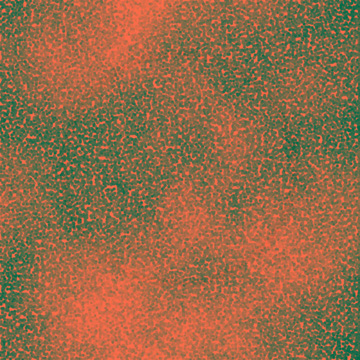Color Blind?
Reverse-Colorblind Test
Color blindness is expressed a person being unable to perceive the full spectrum of colors the way the average human can. Colorblindness itself can be caused by just about any problem with a component of the visual system. I think most types are caused by a person's ganglion cells (the interface between the retina and the optic nerve) not being able to fully distinguish between two colors. Each ganglion cell is designed to be sensitive between two color poles, so if it can't tell one end of it's sensitivity spectrum from the other, a person looses the ability to distinguish that color. The afliction(?) isn't necessarily genetically based, as sometimes trauma can induce colorblindness.
This test is designed to be a kind of 'anti' colorblindness test - i.e. it's one that colorblind people will be able to pass, while normal vision will fail. This experiment came up after a conversation with a good friend of mine - we were wondering if there were images that colorblind people could perceive that normal vision could not. Not sure either? Take the test.
A few notes before actually doing the test
1. Your rods don't detect color, only relative brightness (intensity)
2. The retina is less sensitive to contrast in the red spectrum that in other colors (I'm not sure as to the physiological basis of that, but that's the way it is).
Red Spectrum Gradient
Below is an image (constructed in Photoshop) of a simple red gradient.
Imbedded within the gradient is another image. Can you see it?

If it's painfully obvious that there's another image there, then you're probably colorblind to some degree in the red part of the spectrum. Can't see it? Try looking at the white space at either side of the image, you might be able to see the object by using your contrast-sensitive rods (which are concentrated more heavily in your peripheral vision). Don't give up if you can't see it, that's the whole point - this is an *anti* colorblind test.
Red Speckles
Let's move on to another example, this one more reminiscent of traditional colorblindness tests which use 'bubbles' to obfuscate the edge of the hidden object. You could call these two images a kind of 'reverse color blindness test', so if you're not colorblind, don't feel bad if you can't see anything.
With this next piece, I've hidden another object in the image, again capitalizing on the fact that normal vision humans have a lower degree of color contrast detection in the red spectrum. A colorblind person shouldn't be burdened by that lowered contrast sensitivity and should be able to see the object immediately by picking out the change in contrast at the objects edges (yes, it has edges, that's your first and only clue).

Now that you've spent some time staring at the images, let's go look at what was imbedded in there. Once you've seen the answers, try coming back to these images and looking again (if you didn't see anything the first time). You can probably pick out the objects more easily now that you know what to look for and where to look for it. If you're colorblind, the 'answers' might look to you what the above images looked like to someone who's not colorblind (not sure on that one; email me if you're colorblind and can help me out there).
To the answers
Color blindness is expressed a person being unable to perceive the full spectrum of colors the way the average human can. Colorblindness itself can be caused by just about any problem with a component of the visual system. I think most types are caused by a person's ganglion cells (the interface between the retina and the optic nerve) not being able to fully distinguish between two colors. Each ganglion cell is designed to be sensitive between two color poles, so if it can't tell one end of it's sensitivity spectrum from the other, a person looses the ability to distinguish that color. The afliction(?) isn't necessarily genetically based, as sometimes trauma can induce colorblindness.
This test is designed to be a kind of 'anti' colorblindness test - i.e. it's one that colorblind people will be able to pass, while normal vision will fail. This experiment came up after a conversation with a good friend of mine - we were wondering if there were images that colorblind people could perceive that normal vision could not. Not sure either? Take the test.
A few notes before actually doing the test
1. Your rods don't detect color, only relative brightness (intensity)
2. The retina is less sensitive to contrast in the red spectrum that in other colors (I'm not sure as to the physiological basis of that, but that's the way it is).
Red Spectrum Gradient
Below is an image (constructed in Photoshop) of a simple red gradient.
Imbedded within the gradient is another image. Can you see it?

If it's painfully obvious that there's another image there, then you're probably colorblind to some degree in the red part of the spectrum. Can't see it? Try looking at the white space at either side of the image, you might be able to see the object by using your contrast-sensitive rods (which are concentrated more heavily in your peripheral vision). Don't give up if you can't see it, that's the whole point - this is an *anti* colorblind test.
Red Speckles
Let's move on to another example, this one more reminiscent of traditional colorblindness tests which use 'bubbles' to obfuscate the edge of the hidden object. You could call these two images a kind of 'reverse color blindness test', so if you're not colorblind, don't feel bad if you can't see anything.
With this next piece, I've hidden another object in the image, again capitalizing on the fact that normal vision humans have a lower degree of color contrast detection in the red spectrum. A colorblind person shouldn't be burdened by that lowered contrast sensitivity and should be able to see the object immediately by picking out the change in contrast at the objects edges (yes, it has edges, that's your first and only clue).

Now that you've spent some time staring at the images, let's go look at what was imbedded in there. Once you've seen the answers, try coming back to these images and looking again (if you didn't see anything the first time). You can probably pick out the objects more easily now that you know what to look for and where to look for it. If you're colorblind, the 'answers' might look to you what the above images looked like to someone who's not colorblind (not sure on that one; email me if you're colorblind and can help me out there).
To the answers



4 Comments:
So, after reviewing it on different monitors I'm not color blind... I just have a fancy monitor.
but apon other review... I am a little color blind. Thanks Owl!
Well, I know I'm color blind and I can't see anything eiter. Whaddup widdat?
I always knew I had good vision.
Post a Comment
<< Home